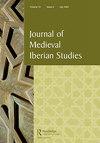金塔纳地名是伊斯兰征服伊比利亚的证据
IF 0.4
2区 历史学
0 MEDIEVAL & RENAISSANCE STUDIES
引用次数: 0
摘要
在本文中,我们探讨了一个长期存在的假设,即非常丰富的金塔纳地名,异常地几乎完全集中在伊比利亚西北部,它们起源于711年的伊斯兰征服。考虑了不同的词源,并指出了它们固有的问题。然后,我们讨论了上述地名在西班牙和葡萄牙的分布,注意到后者与al-Gassani提供的坐标有很强的相关性,据称这些坐标划定了一个根据征服后的土地划分而划分的区域。根据葡萄牙的相关性,我们暂时提出Sajazarra(里奥哈)作为神秘的Sayya的新标识,al-Gassani提供的东部坐标,传统上被解释为指Ejea(萨拉戈萨)。本文章由计算机程序翻译,如有差异,请以英文原文为准。
Quintana place-names as evidence of the Islamic conquest of Iberia
ABSTRACT In this paper we explore the long-standing hypothesis that the very abundant Quintana place-names, anomalously concentrated almost exclusively in northwestern Iberia, have their origin in the Islamic conquest of 711. Alternative etymologies are considered, and their inherent problems noted. We then address the distribution of said toponyms in both Spain and Portugal, noting a strong correlation in the latter with the coordinates provided by al-Gassani and which purportedly delimit an area differentiated in terms of the post-conquest land-partition. In the light of the Portuguese correlation, we tentatively propose Sajazarra (Rioja) as a new identification for the enigmatic Sayya, the eastern coordinate provided by al-Gassani, traditionally interpreted as referring to Ejea (Zaragoza).
求助全文
通过发布文献求助,成功后即可免费获取论文全文。
去求助
来源期刊

Journal of Medieval Iberian Studies
MEDIEVAL & RENAISSANCE STUDIES-
CiteScore
1.20
自引率
20.00%
发文量
24
 求助内容:
求助内容: 应助结果提醒方式:
应助结果提醒方式:


